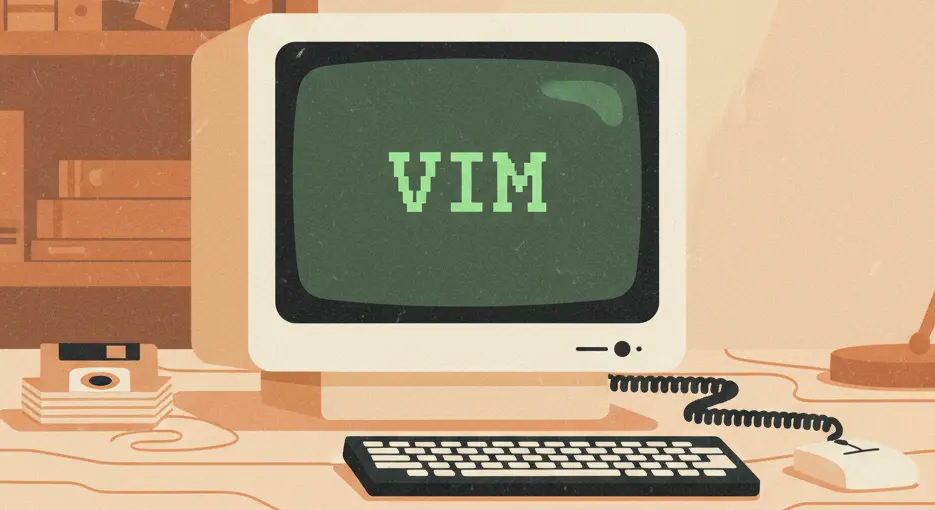
Miguel Aréjula Aísa
- 12/10/2025
Meet Vim: The Powerful Editor Every Developer Should Know
Learn what Vim is, why developers love it and how to master its essential commands to boost your coding productivity.
If you’ve ever seen a developer moving lightning-fast in their terminal and wondered how they’re editing text without touching a mouse; chances are, they’re using Vim.
Vim is one of the most iconic text editors out there. It’s fast, efficient, and surprisingly powerful once you get the hang of it. But let’s be honest, at first, it can look intimidating. The screen is mostly blank, and even quitting the program feels like solving a puzzle.
So why do developers still use Vim after all these years? Because once you learn its rhythm, Vim becomes an extension of your hands. It’s not just about editing text, it’s about flow, speed and control.
By the end of this post, you’ll not only understand Vim, you’ll feel comfortable using it for real projects.
What Is Vim?
Vim is a text editor, but not like the ones you might be used to. It’s not a full-blown IDE, and it doesn’t have flashy buttons or sidebars. Instead, Vim is all about efficiency through the keyboard.
The name Vim actually stands for Vi IMproved, because it’s an enhanced version of an older editor called Vi, which first appeared on UNIX systems back in the 1970s. Even though it’s decades old, Vim is still incredibly popular among developers, system administrators and power users.
Why? Because Vim is:
- Fast: everything happens through keyboard shortcuts. No mouse needed.
- Everywhere: Vim comes pre-installed on most UNIX-like systems (Linux, macOS, even some Windows setups).
- Customizable: you can tweak every little thing, from colors to key bindings.
- Lightweight: it runs smoothly, even on the simplest terminal.
At its core, Vim is designed for efficiency. Instead of typing and clicking around, you use combinations of keys to move, edit and navigate text at lightning speed. It might feel weird at first, but with practice, you’ll realize it’s actually faster than most modern editors once you get into the flow.
Installing and Opening Vim
Before diving into commands, let’s make sure you actually have Vim ready to go. The good news is that Vim is available almost everywhere; Linux, macOS, and even Windows.
On Linux
Most Linux distributions come with Vim pre-installed. You can check by opening your terminal and typing:
vim --versionIf you see some version information, you’re good to go! If not, install it with your system’s package manager:
sudo apt install vim # Ubuntu/Debian
sudo dnf install vim # Fedora
sudo pacman -S vim # ArchOn macOS
macOS also includes a version of Vim by default. To make sure it’s there:
vim --versionIf you prefer the latest version (which often comes with more features), you can install it via Homebrew:
brew install vimOn Windows
You can download the official Windows build from vim.org.
Opening Vim
Once installed, just open your terminal (or PowerShell on Windows) and type:
vimYou’ll see a mostly empty screen with some text explaining basic commands. This is where the magic happens! You’re now inside Vim — but before you start typing, let’s understand one of the most confusing parts at first: modes.
Understanding Vim Modes
One of the first things that surprises (and sometimes scares) new Vim users is that you can’t just start typing right away. That’s because Vim works in modes and each mode changes what your keyboard does.
Once you get this concept, Vim will start to make sense. Here are the main modes you need to know:
1. Normal Mode (the default)
This is the mode you start in when you open Vim. Here, every key on your keyboard is a command, not text input.
For example:
- h, j, k, l → Move the cursor left, down, up, right
- dd → Delete a whole line
- yy → Copy a line
- p → Paste
Think of this mode as command central. You’re giving Vim instructions rather than writing words.
To get back to Normal mode from anywhere, press Esc.
2. Insert Mode (for typing)
Now you’re ready to actually write something. In Insert mode, your keyboard behaves normally, what you type appears on the screen.
To enter Insert mode, press the key i
Once you’re done typing, press Esc to go back to Normal mode.
There are also a few other ways to enter Insert mode:
- a → insert after the cursor
- o → open a new line below the current one
- O → open a new line above the current one
3. Visual Mode (for selecting text)
Visual mode lets you select text, kind of like click-and-drag selection in other editors, but with the keyboard. Start Visual mode pressing the key v.
Then move your cursor with h, j, k, l to select text. Once you’ve selected what you want:
- d → Delete the selected text
- y → Copy the selected text
- c → Change the selected text (deletes it and enters Insert mode)
4. Command-Line Mode (for special commands)
This mode is for meta commands, things like saving, quitting or searching. To enter it, press : (colon) while in Normal mode. Then type your command, for example:
- :w → save your file (“write”)
- :q → quit
- :wq → save and quit
- :q! → quit without saving
Yes, that famous “How do I quit Vim?” question? This is the answer.
Quick Recap
| Mode | Purpose | Enter with | Exit with |
|---|---|---|---|
| Normal | Navigate & run commands | Esc (default) | Esc |
| Insert | Type text | i, a, o, O | Esc |
| Visual | Select text | v | Esc |
| Command-line | Run colon commands | : | Enter or Esc |
Understanding these modes is like unlocking the secret language of Vim. Once you’re comfortable switching between them, everything else becomes much easier.
Essential Vim Commands Every Beginner Should Know
Now that you understand Vim’s modes, it’s time to get hands-on. These are the basic commands every beginner should know. Mastering them will let you navigate, edit and save files confidently.
Navigation
In Normal mode, use these keys to move around:
- h → move left
- j → move down
- k → move up
- l → move right
Other useful commands:
- 0 → move to the beginning of the line
- $ → move to the end of the line
- w → jump to the start of the next word
- b → jump to the beginning of the previous word
Editing
Still in Normal mode, you can edit text efficiently:
- i → enter Insert mode before the cursor
- a → enter Insert mode after the cursor
- o → open a new line below the current one
- O → open a new line above the current one
- x → delete the character under the cursor
- dd → delete the entire line
- yy → copy (yank) the entire line
- p → paste after the cursor
- u → undo the last action
- Ctrl + r → redo
Saving and Quitting
These commands are used in Command-line mode (press : first):
- :w → save the file
- :q → quit Vim
- :wq → save and quit
- :q! → quit without saving
Searching
- /word → search forward for “word”
- ?word → search backward for “word”
- n → repeat the search in the same direction
- N → repeat the search in the opposite direction
Quick Tips
- Always remember that Esc takes you back to Normal mode.
- Start slow, practice moving around and editing before trying more advanced commands.
- Vim has a built-in tutor: run vimtutor in your terminal to follow a guided tutorial.
Customizing Vim and Tips for Getting Comfortable
Vim can feel overwhelming at first, but the good news is that you don’t need to learn everything at once. A few simple customizations and habits can make Vim feel much more comfortable and even enjoyable.
Personalizing Vim
Vim has a configuration file called .vimrc (on Linux/macOS) or _vimrc (on Windows). This file lets you customize Vim to your liking.
Some beginner-friendly tweaks:
" Enable line numbers
set number
" Highlight search results
set hlsearch
" Enable syntax highlighting
syntax on
" Show matching brackets
set showmatch
" Use spaces instead of tabs
set expandtab
set tabstop=4
set shiftwidth=4These changes make it easier to navigate your code, spot errors and keep your files organized.
Tips for Beginners
-
Take it slow Don’t try to memorize all commands at once. Focus on navigation and basic editing first.
-
Practice regularly Even 10–15 minutes a day helps you get used to the modes and keybindings.
-
Use built-in help In Normal mode, type
:helpto access Vim’s comprehensive documentation. For example,:help ddexplains theddcommand. -
Learn from exercises Running
vimtutorin the terminal gives you a guided, hands-on introduction that reinforces the basics. -
Be patient It’s normal to feel confused at first. The “muscle memory” for Vim takes a little time, but once you get it, your editing speed will improve dramatically.
Conclusion
Vim might look intimidating at first, but once you understand its modes, basic commands and some simple customization, it becomes an incredibly powerful and efficient tool. Vim is perfect for fast changes, quick edits and working directly in the terminal.
Remember that the key to mastering Vim isn’t trying to learn everything at once, it’s practicing regularly, starting with navigation and simple editing and gradually adding more commands and features as you go.
By getting comfortable with Vim, you’ll gain a skill that can make editing text faster, more precise and even enjoyable. Plus, it’s a tool that’s everywhere; so the effort you put in will pay off in any environment.
So open Vim, start practicing and embrace the rhythm of this legendary editor. Soon enough, moving, editing and saving text will feel natural, and you’ll wonder how you ever edited without it.
And before you go: if you enjoyed learning Vim, there’s more to explore. Neovim is a modern fork of Vim that has quickly become more popular among developers today. It builds on everything that makes Vim great but adds modern features, better performance and improved extensibility. Many developers now prefer Neovim for daily coding because it’s more flexible and easier to customize.
Stay tuned for the next post, where I’ll dive into Neovim, show you how it differs from Vim and guide you through getting started. Happy coding!

